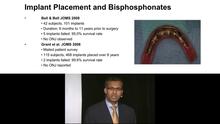-
0
Patient Assessment
- 0.1 Patient demand
- 0.2 Overarching considerations
- 0.3 Local history
- 0.4 Anatomical location
- 0.5 General patient history
-
0.6
Risk assessment & special high risk categories
- 5.1 Risk assessment & special high risk categories
- 5.2 age
- 5.3 Compliance
- 5.4 Smoking
- 5.5 Drug abuse
- 5.6 Recreational drugs and alcohol abuse
- 5.7 Parafunctions
- 5.8 Diabetes
- 5.9 Osteoporosis
- 5.10 Coagulation disorders and anticoagulant therapy
- 5.11 Steroids
- 5.12 Bisphosphonates
- 5.13 BRONJ / ARONJ
- 5.14 Radiotherapy
- 5.15 Risk factors
-
1
Diagnostics
-
1.1
Clinical Assessment
- 0.1 Lip line
- 0.2 Mouth opening
- 0.3 Vertical dimension
- 0.4 Maxillo-mandibular relationship
- 0.5 TMD
- 0.6 Existing prosthesis
- 0.7 Muco-gingival junction
- 0.8 Hyposalivation and Xerostomia
- 1.2 Clinical findings
-
1.3
Clinical diagnostic assessments
- 2.1 Microbiology
- 2.2 Salivary output
-
1.4
Diagnostic imaging
- 3.1 Imaging overview
- 3.2 Intraoral radiographs
- 3.3 Panoramic
- 3.4 CBCT
- 3.5 CT
- 1.5 Diagnostic prosthodontic guides
-
1.1
Clinical Assessment
-
2
Treatment Options
- 2.1 Mucosally-supported
-
2.2
Implant-retained/supported, general
- 1.1 Prosthodontic options overview
- 1.2 Number of implants maxilla and mandible
- 1.3 Time to function
- 1.4 Submerged or non-submerged
- 1.5 Soft tissue management
- 1.6 Hard tissue management, mandible
- 1.7 Hard tissue management, maxilla
- 1.8 Need for grafting
- 1.9 Healed vs fresh extraction socket
- 1.10 Digital treatment planning protocols
- 2.3 Implant prosthetics - removable
-
2.4
Implant prosthetics - fixed
- 2.5 Comprehensive treatment concepts
-
3
Treatment Procedures
-
3.1
Surgical
-
3.2
Removable prosthetics
-
3.3
Fixed prosthetics
-
3.1
Surgical
- 4 Aftercare
Smoking
Key points
- Smoking has a vasoconstrictive effect, reduces blood supply and compromises wound healing
- Smokers experience a significantly higher incidence of periodontitis, dry extraction sockets and post implant surgery complications
- Smokers should be strongly advised to quit smoking completely or at least six weeks prior to implant surgery and other surgical treatment phases and ideally also after treatment completion in order to increase long-term success
Effects of smoking and nicotine on treatment
Smoking and nicotine consumption have a constrictive effect on blood vessels thereby reducing blood supply. It increases the susceptibility to periodontal inflammatory diseases, dry extraction sockets and wound healing complications in general, including wound healing after implant surgery.
Smokers have a 2–4 times higher incidence of periodontitis, peri-implant mucositis and postoperative complications after tooth extraction and any surgical treatment. Smokers also have a higher incidence of osteoporosis, although this may be due to social and economical factors that predispose to both conditions independently.
Smoking patients should be informed about the negative effect smoking has on wound-healing and the reduced implant treatment success rates, especially in the upper jaw. They should stop smoking at least six weeks prior to and eight weeks after implant surgery. By doing so, patients can enjoy the same clinical success outcomes as non-smokers. In some instances, patients may quit smoking for good after this cessation.
It is also the role of any oral health care provider to inform the patient about the general risks of smoking: lung cancer, chronic obstructive lung disease, myocardial infarction (twice as often), osteoporosis, shorter life expectancy vs. lifelong non-smokers.




